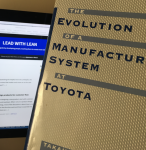Luck it out: commit to learning
Learning means making changes in how you work separating the helpful from the unhelpful, the impactful from the indifferent, adopting the helpful moves that matter and move on to the next change.
So many people look for the “secret ingredient” that will turn their lean efforts into performance transformation. There is nothing secret, it’s been there all along. I’ve been reading again Prof. Taka Fujimoto’s great book The Evolution Of A Manufacturing System At Toyota, after having had the good fortune of meeting the author.

As he pointed out to me, in the book he indeed emphasizes something I had missed completely when I read his book 15 years ago. Toyota didn’t formulate their TPS by getting it right. They did so by being vital. They tried lots of stuff. A few worked, many didn’t. And then events happened randomly as well, some helpful, many unhelpful.
The first point is there’s a lot of luck involved in the evolutionary process to success. The second point is that fortune favors the prepared mind. By having enough people looking for kaizen opportunities and figuring things out, a lean organization is better placed to both seize lucky breaks and make something out of them, as well as cope with unexpected disasters when they accidentally occur. If I understand Fujimoto’s thinking correctly, you make your own luck by working at:
- Routines for problem identification: visualizing problems and diffusing problem information to problem solvers as well as keeping people attuned to problems as a good thing (“Problems first”)
- Routines for problem solving: the skill to search, simulate and evaluate alternatives and the political knowhow to reach out and create allies to solve problems across borders
- Routines for solution retention: the knack to adopt solutions in the routine way of working by formalizing them in procedures and institutionalizing them in the way the business works, which means providing stability for people so they can internalize the changes one by one.
This, however, hinges on a deliberate commitment to learning from the top. As long as the leader “supports” all of this work (all good, carry on) but doesn’t personally commit to:
- learning firsthand and showing it by changing some of his or her behaviors, answers, attitudes
- promoting managers on the basis of their proven learning ability (this means, ability to change step by step in a given direction, and ability to get their people to do so as well)
- refrain from transformative changes from the top that are not validated by small cumulative changes from the gemba
Without which the learning component will be too weak to transform a lean “management system” (which will devolve into bureaucratic routines) into a true learning system (which will bootstrap itself to greater performance).
Lean has al the tools and techniques needed to help you learn, 5S (learn to organize yourself for standardized work), standardized work (learn to optimize your sequence of steps), SMED (learn to change from one task to the next faster) and so on. But unless you bring to the party a personal commitment to learn and work with other learners, al of these will disappoint in the end (beyond the obvious low-hanging fruit). This is the not-so-secret ingredient to lean success.
It’s hard to accept the huge part good or bad fortune plays in our successes and failures, because we, as humans, hate to deal with what is outside our control (we often prefer the illusion of control – budget cycle anyone? – to accepting the chance-driven nature of one damn thing after another). Yet it’s there. It’s precisely because of good fortune and bad that a learning attitude makes such a different. What is the opportunity in a reversal? Can we see a lucky break fro what it is and how fast and further can we move on it? There is no crystal ball, there is no roadmap, but we have a method to make our own luck, if we so wish. It’s called learning.









